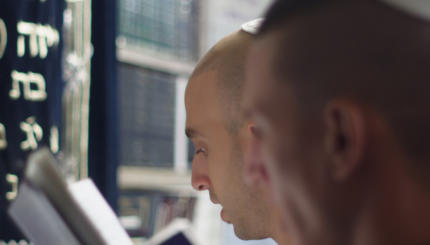In Western society a gentleman “tips his hat” to a lady, and a Christian removes his hat upon entering a church. Not so in the Muslim world. To be bareheaded is to show disrespect and to be barefooted is a sign of reverence. No one is permitted to enter a mosque without first removing his shoes. In Judaism, both the hat and the shoes have retained their symbolic meaning, though not with equal weight or consistency.
If the symbolism of removing the shoes has faded somewhat among the modern Jews, the covering of the head as a symbol of reverence during worship has remained a religious symbol of significance. But the origin and development of this religious symbol is shrouded in uncertainty. We know that among the priestly vestments of Aaron and his sons there was a “headdress” for Aaron (Exodus 28:4) and “turbans” for Aaron’s sons (Exodus 28:40). These, the Bible tells us, were “for dignity and adornment.” In the [Babylonian] Talmud we read a lone but telling reference:
Rabina was sitting before R. Jeremiah of Difti, when a certain man passed by without covering his head [as a sign of respect]. How impudent is that man! he exclaimed. (Kiddushin 33a)
Moses Maimonides [12th-century Spain/North Africa] makes reference to this Talmudic incident in his famous philosophic work, The Guide of the Perplexed. He says: “The great men among our Sages would not uncover their heads because they believed that God’s glory was round them and over them.”
Though covering one’s head was regarded during the Talmudic period as a sign of respect, there is scant evidence that Jews in the Temple court or in the early synagogue were required to wear any headgear. In Christian Europe we have evidence of a disregard for this tradition, or at least inconsistency in its observance. “In the thirteenth century,” says Israel Abrahams, quoting a contemporary work, “boys in Germany and adults in France were called to the Law in synagogue bareheaded” (Abrahams, Jewish Life in the Middle Ages, London 1932, 301-2).

Help us keep Jewish knowledge accessible to millions of people around the world.
Your donation to My Jewish Learning fuels endless journeys of Jewish discovery. With your help, My Jewish Learning can continue to provide nonstop opportunities for learning, connection and growth.
With the passage of time, the custom of covering the head during worship increasingly became mandatory. As the persecutions by the Church increased, the Jewish aversion to everything Christian deepened. The uncovering of the head became associated with Church etiquette and therefore became repugnant. To worship or even to go about with an uncovered head was regarded as imitation of the Christians and an act of irreverence to God. Conversely, the covering of one’s head became an act of Jewish piety. For convenience the skullcap, or yarmulke, was adopted.
In modern times the headdress is an indispensable part of the Jew’s attire at worship. It is quite unthinkable for anyone to enter an Orthodox or Conservative synagogue, let alone participate in the worship, with an uncovered head.
When the Reform movement was launched in the 19th century, the head covering at prayer was abolished. Hatless worship in the Reform synagogues became a mark of distinction and a barrier between the Reform and the other branches of Judaism no less than the theological differences and the liturgical changes. [But in many Reform synagogues, head covering is now the norm.]



